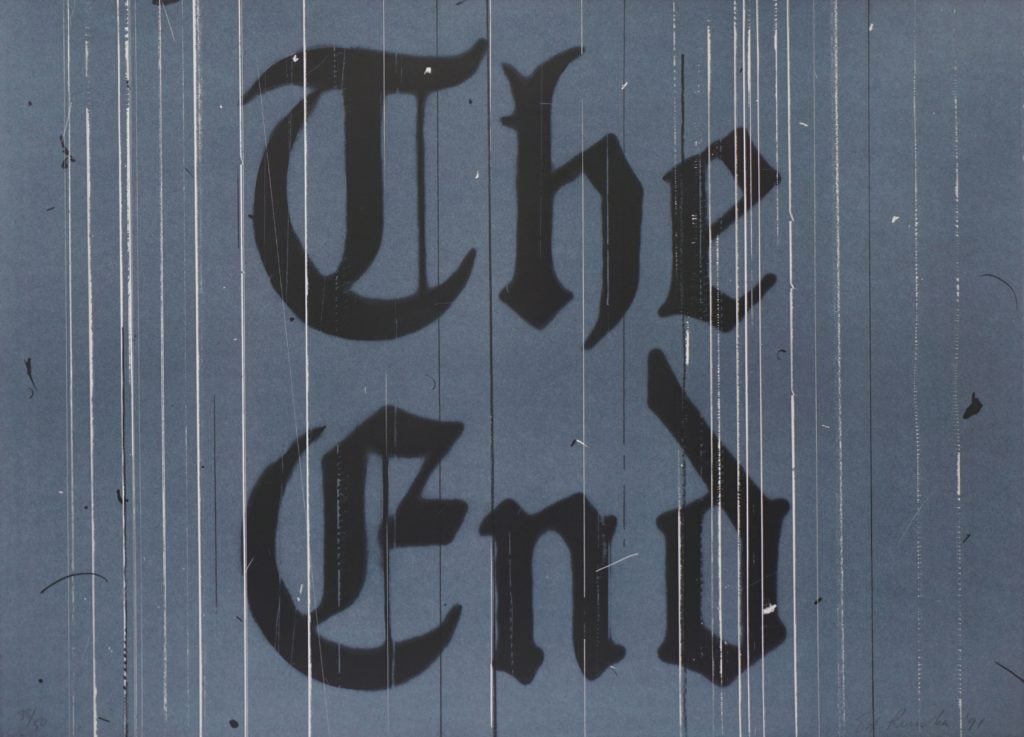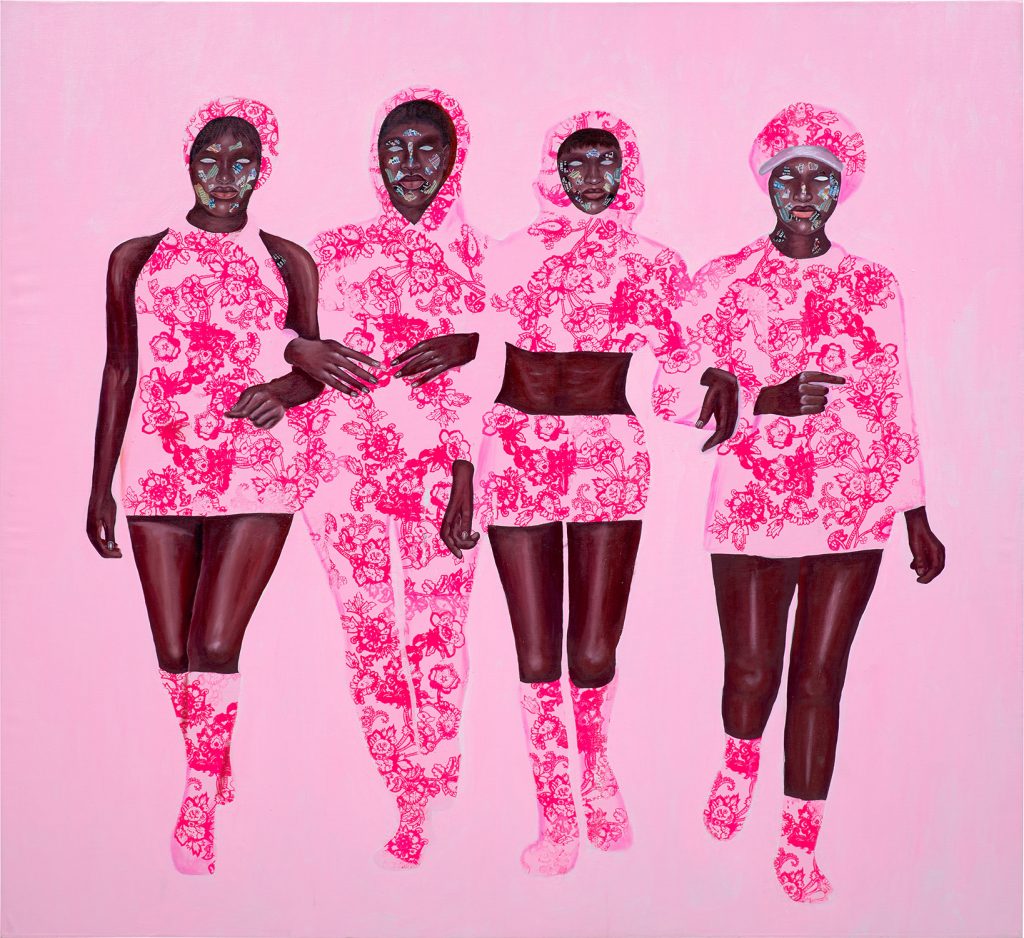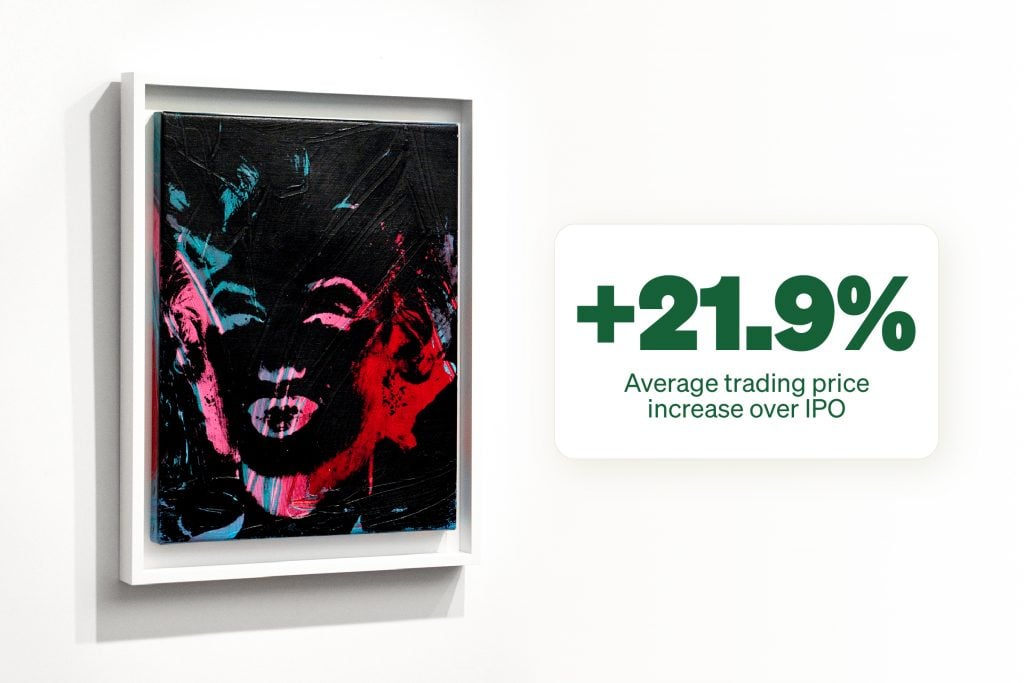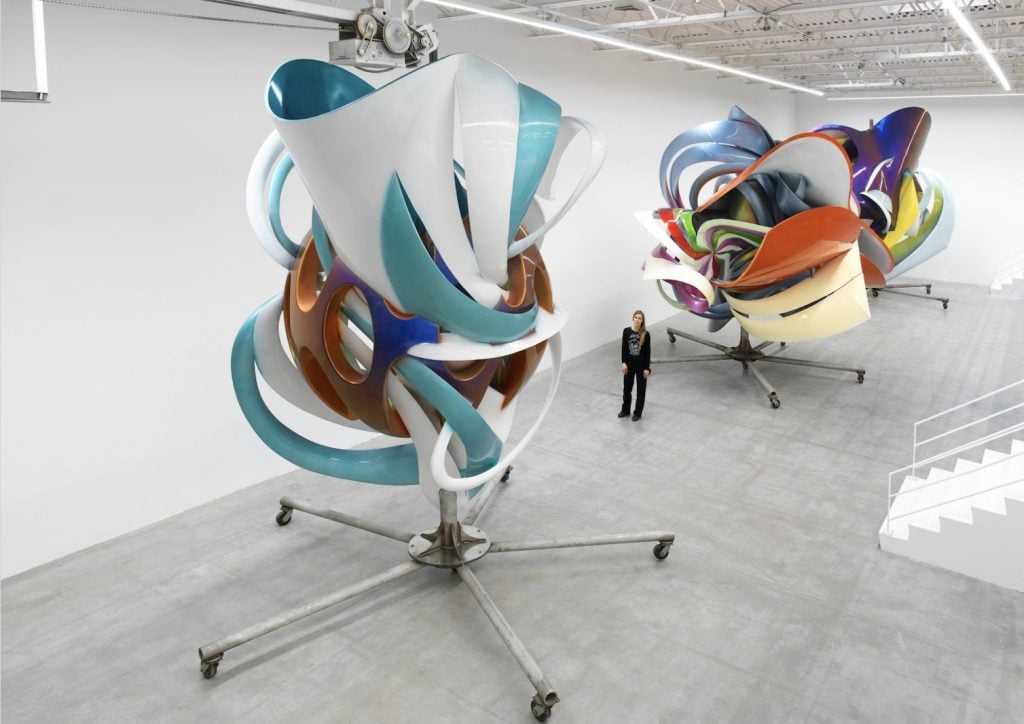The Art Detective
‘It’s Not a Soft Landing’: Contemporary Art Prices Come Crashing Down. Is This the End?
Current market conditions challenge the popular belief that art always goes up.

Current market conditions challenge the popular belief that art always goes up.

Katya Kazakina

The fog of flipping is lifting, and the emerging landscape is littered with casualties.
Just look at any number of contemporary art auctions that occurred this month. “Contemporary Curated” at Sotheby’s on March 1: 82 percent of lots sold (after 22 lots were withdrawn). “New Now” at Phillips on March 12: 72 percent sold by lot (after 12 withdrawals). “Postwar to Present” at Christie’s on March 13: 73 percent sold by lot (with 8 lots withdrawn). And much of what did sell went for well below previous highs.
“There’s a bit of a carnage in the market at the moment,” one collector told me, as we reviewed the results. “Many things are not selling at all or selling for a fraction of what they used to.”
A glaring example: Emmanuel Taku’s painting Sisters in Pink, which I featured in a column about the soaring prices for emerging African artists two years ago.
The painting first hit the auction block in 2021, the year it was painted, after a couple of rapid-fire flips. It fetched a whooping $189,000 against a top estimate of $35,000.
Its new owner had no such luck this month: Sisters in Pink hammered at just $8,000 against an estimate of $10,000 to $15,000.
Let that sink in: Someone who bought the painting for $189,000 sold it for $8,000 three years later. No, I am not missing a zero.
That stark result got me thinking about how people in the art industry think about prices, myself included.
Over the past two decades, there emerged a perception of art as an alternative asset that could—with the right moves and timing—store value as well as (if not better than) traditional assets like stocks, bonds, and real estate.
But what happens to this narrative when prices come crashing down, as they are now? Why does investment-grade art appear to be a lot less liquid than even two years ago? Are we facing a future where investors may be hard-pressed to recoup their money? How did we get here?
I will examine these topical questions in a series of articles. But first, allow me to backtrack.

Emmanuel Taku, Sisters in Pink (2021). Courtesy: Phillips.
When I started on the art-market beat at Bloomberg in 2006, discussing prices was considered borderline gauche. I had to jump through all kinds of hoops to get prices from the galleries. At art fairs, many dealers would take one look at my press badge and clam up.
Things changed as the financialization of art became a huge story. Auction houses and galleries realized that they could generate a lot of publicity with big prices. Here are some typical Bloomberg headlines from years past:
– “$110 Million Basquiat Sold by Family Who Bought It for $19,000”
– “A Brass Sculpture Could Deliver a 1,400,000% Return for Heirs”
– “How to Handle the $85 Million Gain From That Basquiat Windfall”
I once worked with an editor who pioneered art-market coverage at the Wall Street Journal in the 1970s. He urged me to do a story about the market’s big problem: liquidity. “Art is very hard to resell,” he said. I shrugged it off, laser-focused as I was on art as an investment.
Now I am finally doing it—or, at least, dipping my toes into this massive topic. I was tempted to call it “the art market’s dirty secret,” but no one I spoke with seemed surprised.
“I’d say that 85 percent or 90 percent of all art is like a new car,” one art advisor told me. “As soon as you roll it off the lot, it’s worth a lot less—except for the very rare collectors’ cars that have waiting lists and, for the time being, are worth a heck of a lot more.”
The advisor, who has a thriving business, asked not to be named, and it’s easy to see why. The transactional fever of the past two decades has been built on the notion that art rivals stocks and real estate as an investment.
Fractional-ownership companies like Masterworks are selling the dream to small investors, while art funds target wealthy ones with blue-chip trophies, and art bros speculate on hot emerging names. Market insiders just kept smiling and ringing the register. Cha-ching!

A promotional image for Masterworks’s offering of shares in Andy Warhol’s 1 Colored Marilyn (Reversal Series) (1979). Courtesy of Masterworks.
Over the past year, I began hearing concerns about a growing disconnect between the primary and secondary markets. Primary prices have gotten so high for many artists that they cannot be resold for a profit any longer, sources told me.
That complaint speaks volumes about this investment-obsessed moment in the art world.
“Until relatively recently, the common wisdom was that if art held its value over time, that was a success,” an auction executive said. “Most importantly, you had the pleasure of living with it, and if you could sell it years later and get your money back, that was impressive.”
The newer narrative has been seductive for all involved. Headlines touting major returns have convinced many that buying art low and selling high is a walk in the park.
It isn’t.
“If you are lucky, and if you buy smartly,” the advisor likes to remind clients, “one of the 10 things in 20 years will pay several times over and will pay for the rest of your art collection that might be worth next to nothing.”
There are plenty of cautionary tales: Anselm Reyle, Zombie Formalism, and more recently, Rudolf Stingel and Wade Guyton, whose markets suffered in the aftermath of the Inigo Philbrick fraud.
Galleries work hard to create the imprimatur of value by building up their brands and placing prized artworks in prestigious collections, museums settings, and biennials. An entire ecosystem is there to reinforce the belief that art goes up.
“The average rich person wants to believe that it’s true,” another advisor said.
Just a few examples can demonstrate the actual reality.
Take Pat Steir, a revered octogenarian whose 14 new paintings at Hauser & Wirth in Los Angeles sold in 24 hours, I hear, at prices ranging from $700,000 to $850,000. A quick search of the Artnet Price Database reveals that just 10 works by Steir (out of the 167 listed) fetched more than $700,000 at auction. The artist’s auction record of $2.3 million was set back in 2018.

Installation view of “Frank Stella: Recent Sculpture” at Jeffrey Deitch gallery. Photos by Genevieve Hanson. ©2024 Frank Stella / Artists Rights Society (ARS)
Ditto Frank Stella. On March 1, a massive sculpture he made in 1982 was sold without a reserve at Sotheby’s for just $48,260 against a low estimate of $150,000. His new works are currently priced at $2.5 million at Jeffrey Deitch in New York. “They cost so much to make that the asking price is not that much more than the fabrication,” Deitch said. “When people seeing these new works they are stunned.”
Ditto Oscar Murillo, whose new paintings have been sold by David Zwirner for $350,000, $400,000, and $500,000, according to Artnet’s invaluable Price Check column. Meanwhile, Murillo’s recent auction prices are a fraction of those figures. Since the pandemic, 50 paintings by the Colombian artist came up for sale and a quarter flopped—including, most recently, a painting at Phillips in London that was estimated at £50,000 to £70,000 ($63,000–$88,000), according to the Artnet Price Database. His auction record, $401,000, was set in 2013.
Ditto Dan Colen, another erstwhile speculators’ darling, whose large-scale painting Vengeance (2015) from Miami’s esteemed de La Cruz collection, recently fetched $15,400 at Sotheby’s. New paintings of its size retailed for $450,000 on the primary market, according to people familiar with his pricing. It’s safe to assume that the mega collectors got a mega discount, but even so, the question looms: Why would the market-savvy family take such a huge loss? (The answer will have to wait: Sadly, Rosa de la Cruz died last month.)
Ditto Loie Hollowell, who has her first museum show at the Aldrich in Ridgefield, Connecticut, right now. Her painting Lick Lick in Blue, Green and Yellow (2015), estimated at $500,000 to $700,000, didn’t find a taker at Christie’s earlier this month.

Dan Colen’s painting Vengeance (2015), right, at the de la Cruz Collection in Miami during Art Basel Miami Beach in 2017. Photo: Katya Kazakina
This could go on and on, including artists at every price point and career stage. Here are some whose works didn’t sell at the most recent Phillips auction: Robert Rauschenberg, Hank Willis Thomas, Lisa Yuskavage, Vaughn Spann, Peter Saul, Petra Cortright.
“It’s not a soft landing,” Deitch said of the current market conditions.
How do collectors feel about this? Naturally, opinions vary.
Many agree that primary prices have gotten too high. Some are clearing out their art storage and dumping the contents at auction before it all goes down to zero. Others don’t concern themselves with the market.
“I don’t buy art because I think that the prices are going to go up,” said Beth Rudin DeWoody, a veteran collector and philanthropist. “There are a lot of young artists. I have no idea what’s going to happen with their careers. I like to support young artists or artists who’ve been overlooked. Sometimes they do go up and sometimes they don’t.”
Evan Ruster, who’s been collecting for more than two decades, considers himself lucky when it comes to his art acquisitions. He’s made a couple of shrewd sales along the way, but doesn’t buy art with a plan to resell it.
“You are buying because you love it,” said Ruster. “It’s a passion. So you are not rational in a way.”
How do you price art, anyway?
“It’s so subjective,” Ruster said. “You are like: I just bought a piece of paper with some marks on it. I could have bought a fucking Audi.”